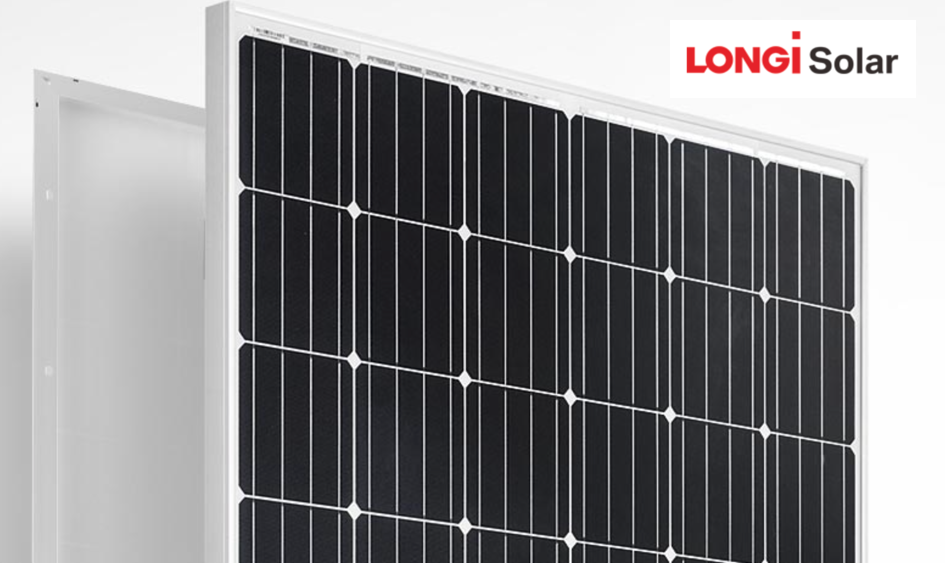
Quite Possibly The Largest Monosilicon Solar Panel Producer In The World…
Longi Solar is a Chinese company that has accumulated solar panel production capacity at a prodigious pace.
Also, they’ve grown really fast.
Update 12th November 2019: Longi now has an Australian office in North Sydney. I spoke to them and they said that, while the installer is the first port of call if there is a problem, they will handle warranty claims for any Longi panels in Australia. This includes those put in by installers that have gone out of business.
They shipped 2.34 gigawatts of panels in 2016 but claimed to have 5 gigawatts of panel production capacity at the end of that year. As they only use monosilicon solar cells this potentially makes them the largest monosilicon solar panel producer in the world.
They only produced 1.259 gigawatts of panels in the first half of this year, which was 11% less than in the last half of 2016 and much less than I would have expected from a company with the capacity to produce almost twice that much, but apparently their output is still high enough for them to be a new member of the “Silicon Module Super League” which is the group of now 7 companies that produce around half the world’s solar panels. I guess it’s kind of like the Justice League for solar, which is cool, unless of course Longi is Aquaman, as there is nothing cool about him1.

But perhaps I should stop making fun of Aquaman, since Atlantis sits next to Australia in the UN. (And I have to say, I love what her Excellency, Gillian Bird, has done with her hair.)
So far most of their production has been used in China, but Longi has been busting into overseas markets and becoming more popular in Australia, so you can now read about them on our review page here — where you can leave your own review if you happen to have them installed.
Longi panels are tier one. While this is not a guarantee of quality, it is a good indicator, and my advice has always been to not buy anything that isn’t either tier one or from a manufacturer known to produce reliable panels.
The panels come with a 10 year product warranty and a 25 year performance warranty that allows for less degradation than most other panels in their price range. Longi doesn’t have an office in Australia so the importer of the panels is responsible for their warranties. Hopefully, they’ll prove reliable enough so you’ll never have to worry about using their warranties.
Company History
Longi was founded in the year 2000 and by 2007 they had 100 tonnes of monosilicon production capacity. Nowadays, that’s enough for around one gigawatt of solar panels, but back then it was probably less, as they were still cutting silicon ingots into the thicker “toast” slices rather than the thinner “sandwich” silicon ingot loafs they do today where they are cut so thin there is only around half a gram of silicon per solar cell.
In 2014 they were able to ship 2.5 gigawatts worth of silicon wafers, which are slices of silicon ingot before they are turned into solar cells. This was also the year they stopped just producing silicon ingots and wafers and got into solar panel manufacturing by acquiring Lerri Solar.
Lerri had been producing solar panels since 2007. After buying them, Longi continued to produce panels under the Lerri name until early this year when Lerri Panels were rebranded as Longi Solar. It is possible Longi held off on the rebranding because they wanted to be sure panel reliability was up to scratch before putting their name on them.
From 2014 to 2016 Longi has expanded more rapidly than me when I spent a month in America2. In 2016 they were the fastest growing panel manufacturer in the world. Most of their production has been installed in China, but they are now looking to spread their wares all over the world.
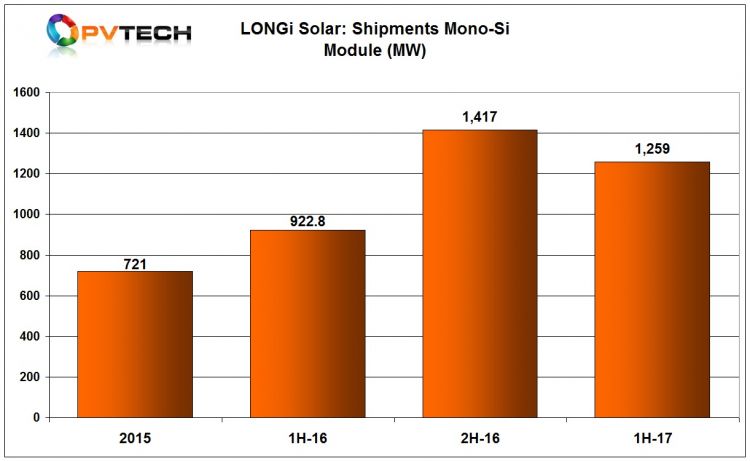
Despite slacking off a bit in the first half of this year, you can see Longi has been pretty busy. (Image Credit: I got this graph off a Longi press release, but as you can see from the logo, they got it straight from PVTECH.)
Longi Headquarters
Longi was founded in the year 2000 in the city of Xian, or Xi’an if you have a stutter. This city is located in Shaanxi Province, but Longi says on its website this city is located in the neighboring Shanxi Province. Somehow they managed to confuse Shaanxi and Shanxi when writing about them in a foreign language. I can’t imagine how that happened.
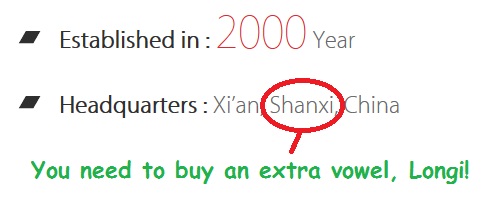
Yes, of course we can bloody well trust them — within reason. We’d be mugs to judge them based on a spelling mistake. Overall, Longi’s use of English is excellent compared to some other Chinese companies. They write almost as good as I do.
Most of the world’s solar panels are made near Shanghai, but Longi is headquartered further north in Xi’an, because they started as a silicon manufacturer. As they only produce monosilicon which requires a great deal of electrical energy, they were founded in a place with cheap coal power.
Now burning coal is what we scientists call very, very bad. But solar panels produced with coal power are still an environmental plus. I’ll also point out that, to our shame, China now produces less than 60% of its electricity from coal while in Australia it was around 74% last financial year. So it’s not good that Longi is slurping down a considerable amount of coal power to make its silicon, but at least the Chinese government recognizes there is a problem and is taking significant steps to reduce coal use and cut emissions. Let’s hope Australia does the same before China and other countries get to the point they start slapping trade sanctions on us.
Overseas Production
In addition to their Chinese factories, Longi is expanding production overseas. Not in Australia though. That would be a hard sell what with the way our currency bounces up and down. There’s a reason why our dollar coin has a kangaroo on it, you know.
Longi is building a factory in India capable of producing 500 megawatts of panels a year. It will be located in the Special Economic Zone (SEZ) in Sri City near India’s center for launching things into space in Andhra Pradesh. It will employ 1,000 people, which is a lot for a 500 megawatt plant these days, but wages are lower in India than China, so it’s not odd they are hiring more people than they would back home.
They have also bought a facility in Malaysia which will produce 500 MW of solar panels a year when ready. It will be quite self contained and ship in silicon ingots, cut them into wafers, make solar cells and panels, and then throw all the pieces of waste silicon into crucibles to produce new ingots on site.
Longi Makes Monosilicon Only — No Polysilicon
There are two types of silicon used to make solar cells — polysilicon and monosilicon.
Polysilicon is relatively easy to make. Molten silicon is poured into a mold the desired size and allowed to cool. It’s quick, easy, and there’s not much waste. Its disadvantage is it is made up of multiple crystals of silicon that reduces the efficiency of solar cells.
Monosilicon is a lot harder to make and so more expensive, but but results in a single large crystal of silicon allowing solar cells be more efficient.
Longi only makes monosilicon and is the world’s largest producer of the stuff — at least when it comes to making ingots. They own a huge number of special slow cookers that bake and rotate at just the right rate to produce cylindrical ingots of silicon using the difficult to pronounce process. Ingots used for solar cell production are typically 10 to 20 centimeters across.
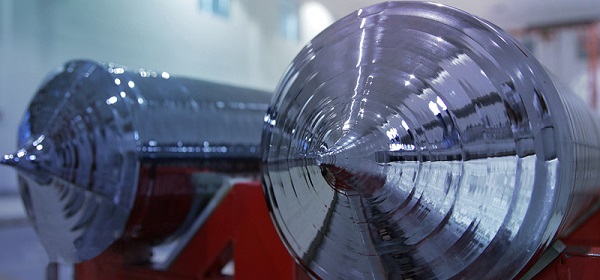
A perky pair of silicon ingots all ready to be sliced into wafers. (Image Credit: PVTECH, despite the fact I actually got it from a Longi press release.)
The slow cookers are actually called crucibles on account of how they get a fair bit hotter than the average tofu curry and reach Guatemalan Insanity Pepper temperatures of 1,425 degrees. To withstand this the crucibles are usually made of quartz which has a melting point of 1,713 degrees.
Quartz is a large chunk of crystalline silicon dioxide, which is what sand is made of, which is what the silicon used to make solar cells was obtained from. You know, it doesn’t seem that long since we were using quartz to make spearheads to conquer nature and now we’re using it to try to stop ourselves from finishing her off.
Longi Is Vertically Integrated
Longi makes silicon ingots, cuts them into wafers, makes solar cells from them, and then turns them into solar panels. Because they handle different stages of production they are a vertically integrated company.
Looking at a difficult to read graph of planned manufacturing capacity, it is possible to see their planned panel production and cell production don’t necessarily match up — or at least you can see that if you squint a bit:
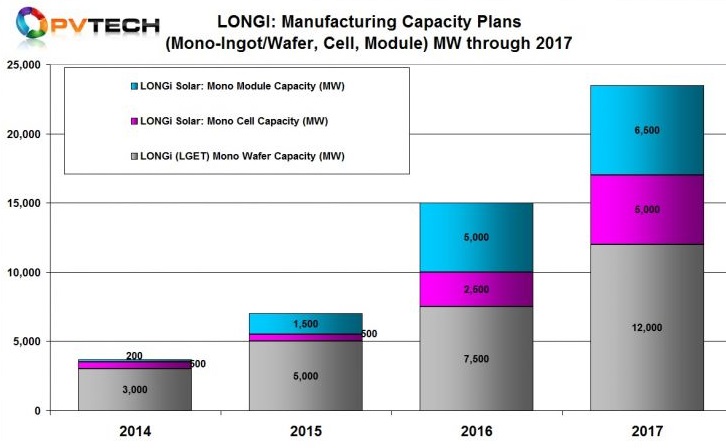
This graph shows Longi’s past production and this year’s planned production. (Image Credit: PVTECH. This time I got the image straight from the horse’s mouth. This is unusual, because normally I don’t want something after it’s been in a horse’s mouth.)
But as they produced 2.39 gigawatts of panels in 2016 and only 1.259 gigawatts of panels in the first half of the year, their panel output may closely match their cell production and they may not be buying cells from other companies to make up the difference.
Monosilicon Makes For Efficient Panels
As monosilicon allows panels to be more efficient than polysilicon, Longi’s efficiencies are reasonably high. Their 60 cell panels are most likely to end up on Australian roofs and their efficiencies range from 17.4% to 19%.
Longi takes part in China’s Top Runner Program, which is a scheme designed to boost Chinese solar panel efficiency.
Efficiency Record For Mass Produced PERC Cell
Just a few days ago Longi announced they had achieved a new cell efficiency record for mass produced PERC cells of 22.43%. This is cell efficiency and so panels made from these cells won’t perform quite as well, but it is still an impressive development — despite Jinko beating them about a day later.
Monosilicon Risk
Being so heavily invested in monosilicon and owning so many dedicated monosilicon slow cookers means that Longi is at risk of being stuck with a load of outdated expensive equipment if there are significant cost declines in other methods of producing silicon. But because solar production is expanding so rapidly, even if clearly more economic methods are developed, old and new technologies may be able to coexist for a long time.
Their Performance Warranty Is Better Than Average
Premium solar panels can have a performance warranty far better than average. For example SunPower now guarantees their X and E series panels will produce at least 88% of their originally rated power after 25 years.
Unfortunately, most lower cost tier one solar panels only guarantee around 80% output after that long. But despite not being what I would call a premium panel, Longi’s performance warranty is better than average and promises a minimum of 83.1% for their standard panels and 84.8% for their PERC panels after 25 years.
I hope other tier one panel manufacturers will feel confident enough in their panels to raise their performance warranties closer to Longi’s.
Update 1st Nov 2017: I previously gave a much better and incorrect figure for Longi panel’s performance warranty. This is because their datasheets prominently state, “25-year Power Warranty Annual Power Attenuation -0.55%” and I was stupid enough to believe them. I hope Longi fixes that before they run afoul of Australian consumer law. I don’t know if I count as a reasonable person, but I think a reasonable person could believe the actual performance warranty is -0.55% a year for 25 years.
Longi Stole A Great Man’s Name
I’ve told you all sorts of things about Longi. I’ve mentioned their rapid expansion, their monosilicon obsession, and their perky ingots. You may think I’ve told you the longi and the short of it. But now it’s time to talk about the serious issue of how they are dastardly name-stealing ruffians.
It is extremely obvious that, in a pathetic attempt to hang off the coattails of his fame, Longi named themselves after Australian solar legend, Jack “Longy” Long, the man with the photosynthetic skin3.
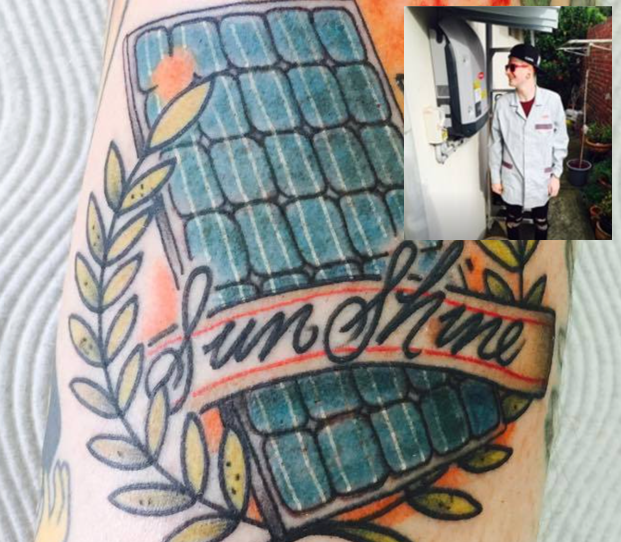
Jack ‘Longy’ Long. He loves solar so much, he got the tattoo.
Some nitpickers may point out that Jack “Longy” Long was only about 10 years old when Longi was formed back in 2000 and had yet to scale the heights of fame he has since reached. But I say his fame is so epic it is clearly capable of reverberating backwards through time as well as forwards.
In order to atone for their name stealing, Longi really should make him CEO. It’s the least they could do. If they’re not willing to do that they should at least give him some sort of title, such as Vice-President In Charge Of Having An Epic Name. We can be flexible on just what the exact title will be, provided it gives more prestige than Aquaman has.
Recommendation
So when all is said and done, would I be willing to install Longi solar panels on my roof?
Yeah, sure. Why not? They’re tier one and should be reliable.
But at the absolute minimum, they need to buy Jack “Longy” Long a beer.
Footnotes
- The only possible way to make Aquaman cool would be to use the guy who played Khal Drogo in Game of Chairs and forbid him from speaking English. ↩
- Mmmmm…obesity… ↩
- While it is true that all mammals have photosynthetic skin as they can use sunlight to synthesize vitamin D, this in no way changes the veracity of my previous statement. ↩

 RSS - Posts
RSS - Posts



Sunpower have upgraded their warranty to 92% on the E and X series FYI,
I heard about that, but it still comes to about 88% according to the information currently on their Australian website. Maybe they think Australian conditions are particularly harsh? Or it could be they just haven’t updated the information.
Is it possible to put the prices of panels on your reviews? It is impossible to work out which panel to ask installers for.
I am afraid that the prices are always changing. Usually trending down, but sometimes going up due to currency fluctuations or increases in demand. However, our Solar 101: A Beginners Guide does show reliable brands in approximate order of lowest cost to most expensive:
https://www.solarquotes.com.au/solar101.html
In practice, individual installers generally only have a few kinds of panels they normally install and get good prices for them by ordering in bulk. If you want a panel they don’t carry they may be happy to order it, but the price may not be great since they’ll only be ordering enough for you. As a result, finding the deal that is the best value for money often involves picking the best out of what is on offer, rather than ordering a panel that may appear to be good value for money.
Longi performance warranty for LR6-60PE series after 25 years should be 84.8% according to datasheet.
Ah yes, you are right. While they clearly state on the datasheet, “25-year Power Warranty Annual Power Attenuation -0.55%” which would give 87.1% over 25 years, looking more carefully I see it is only 83.8% for their standard panels and 84.8% for their PERCs. I should have realized 87.1% was too good to be true and been more suspicious.
I will update the article at once. Thank you very much for pointing this out to me.
Can a older deep cycle battery influence the output of solar cells? I have been off the grid for 15 years with 2kw of an array of 12 * 80 W and 6 * 150 W panels connected to a Century Enersun 850 ah battery connected at 48 volts. Output has dropped over time and I wonder if the internal battery resistance has increased and inhibits the Solar production. The drop off is very poor on cloudy days. I am thinking it is just decreased output from the cells is the problem. Have you any suggestions please? Mike
I would not expect aging battery to affect the output of solar cells. If your lead-acid battery is in age related decline its capacity could be falling fairly rapidly. But if the problem is it is taking longer to charge than it did in the past, it suggests your panel output has fallen. I’d suggest checking the output of individual panels in full sun to see if they produce close to their rated output. While well made panels can still be going strong with only a mild decline after 15 years, I am afraid that’s more than long enough for many panels to have severely deteriorated.
Do Longi have an office in Australia now?
I’m afraid there is no mention of an Australian office on Longi’s website and they aren’t in the White Pages.
What do you think of Longi + huawei 5kw hybrid inverter?
Longi have shown themselves to be reliable panels so far and their performance warranty allows for a little less degradation than average, so if they do have a problem in the future it will be a little easier to get them replaced under performance warranty. Huawei inverters haven’t been available in Australia long enough to prove themselves but they have a better than average warranty and a low price point. I wrote about them here:
https://www.solarquotes.com.au/blog/huawei-solar-inverter-review/
A Huawei inverter is the cheapest way I know to add an LG Chem RESUH battery but it won’t be able to provide backup power during a blackout. (Note that batteries won’t pay for themselves yet with the possible exception of South Australia and some special circumstances.)
What would you recommend between Longi and Risen panels? And the Goodwe inverter.
Risen has a 12 year product warranty while Longi has a 10 year product warranty, so I would lean towards Risen, all else equal. Longi’s performance warranty allows for slightly less deterioration in panel output over time, but I don’t see that as being as large an advantage. You can compare solar panels on our table here:
https://www.solarquotes.com.au/panels/comparison/compare-solar-panels/
A Goodwe is a lower cost budget inverter. It may be decent value for money, but you can’t expect it to be as reliable as a premium brand such as a Fronius.
If they don’t have an Australian office, is there a distributor for them in Australia?
Who do I need to contact if my installer is no longer around and my panels have issues?
I don’t know of any single distributor for Longi Solar, although it is possible they have an exclusive deal with an importer or distributor. If you already have Longi panels the information will hopefully be in your documentation. If your installer directly imported them and they disappear I’m afraid you will have no warranty coverage. If you are thinking of getting Longi panels it’s a good idea to find out the importer and checking to see how long they have been in business.
Longi now have an office in North Sydney listed on their web site.
Thanks very much for the heads up. I have updated the article.
Thanks for the advice Ronald
Are longi panels worth the extra $400 over Suntech panels
What is the difference in a Longi LR4-60HPH and a Longi LR6 panel?
There’s not a lot of difference between them.
From the Longi Solar Australian site here’s the LR6 datasheet:
https://www.longi-solar.com.au/uploads/attach/20200528/5ecf236ec3697.pdf
And here’s the LR4:
https://www.longi-solar.com.au/uploads/attach/20200528/5ecf233a0bc53.pdf
The LR4 can have a higher efficiency which can help if roof space is limited. There’s a slight difference is size and the LR4 handles heat just a little better but the difference is so small it’s not really worth worrying about. They both have 12 year product warranties and their 25 year performance warranties allow for less deterioration than average, which is good.